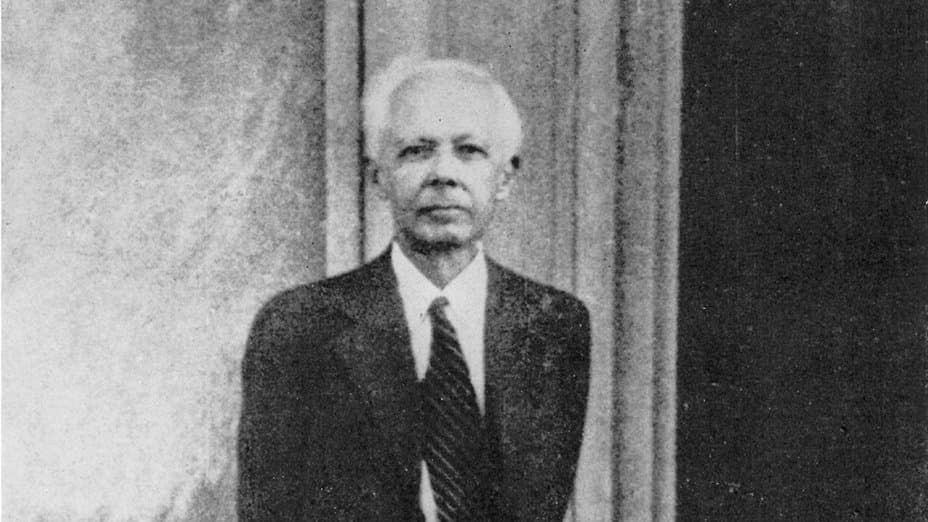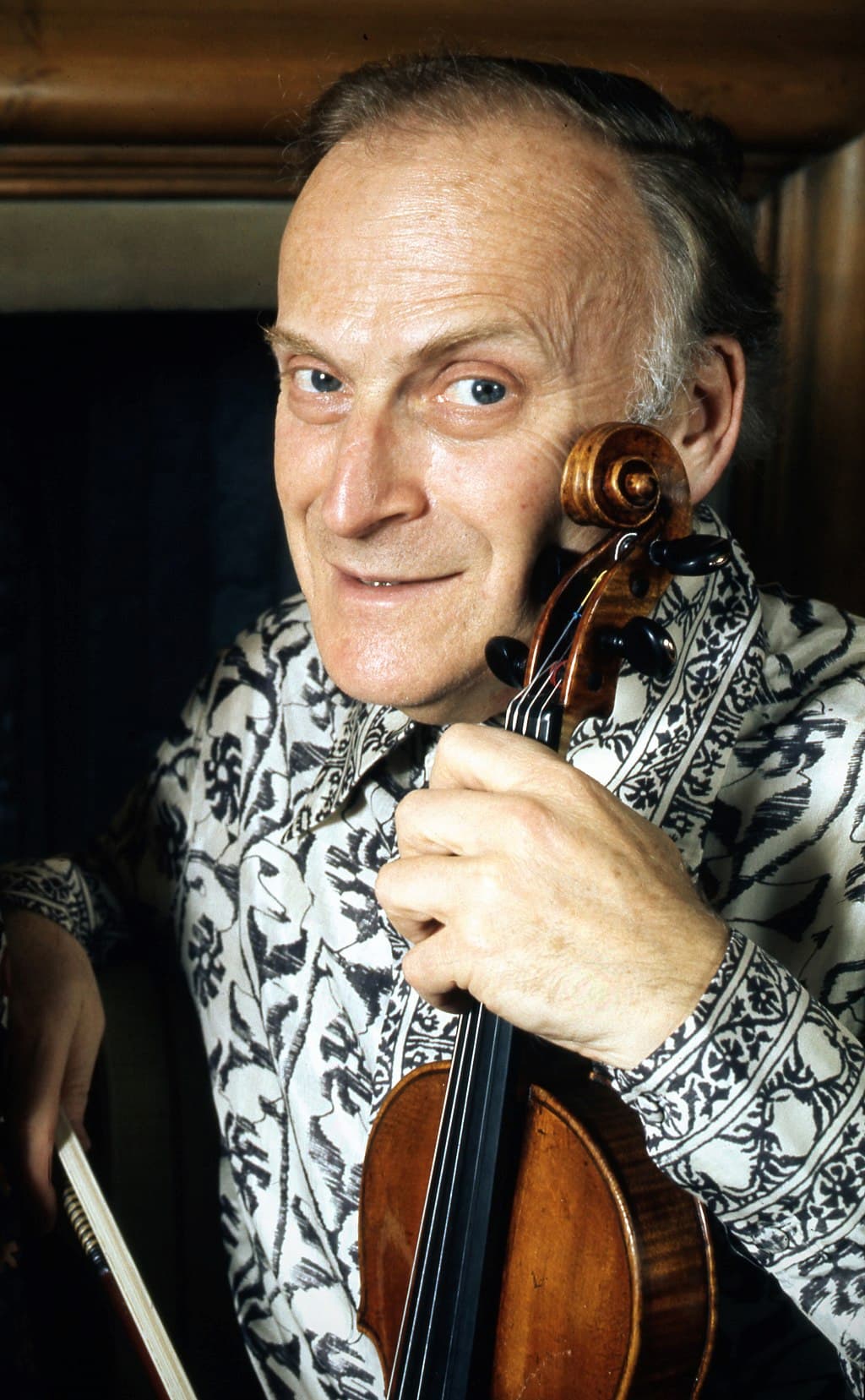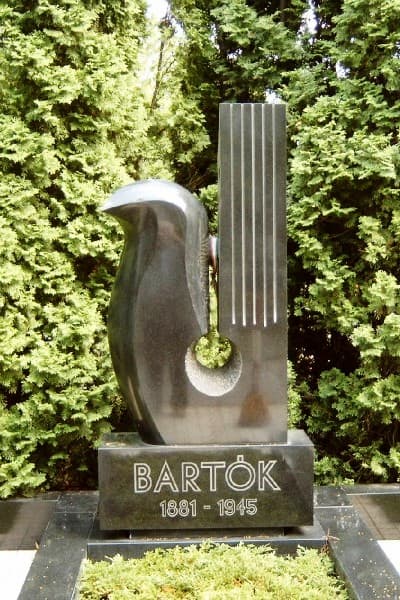Béla Bartók was diagnosed with Leukaemia in April 1944, and as his body gradually failed, he found creative energy and produced a final set of masterpieces inspired by Yehudi Menuhin, Fritz Reiner, and Serge Koussevitzky. Bartók died at age 64, on 26 September 1945. The funeral service was held at Universal Chapel, and the burial took place at Ferncliff Cemetery in Hartsdale, New York. The funeral was a small family affair, and it included his wife Ditta Pasztory, their son Péter, and his pianist friend György Sándor.
Béla Bartók: Concerto for Orchestra
Immigration

Béla Bartók and his wife Ditta Pasztory
With war looming on the European Continent, Bartók and his wife Ditta had reluctantly immigrated to the United States in 1940. They settled in New York City but found life rather difficult. Bartók’s mature musical language, which integrated folk idioms within strict contrapuntal forms, simply did not resonate with the American public.
Since there was little interest in his music, the couple lived on money received from a meagre research fellowship from Columbia University, and from charitable handouts from his friends and supporters. Concordantly, Bartók’s health gradually started to fail. For years he battled bouts of fever and exhaustion, but doctors were unable to diagnose the underlying medical condition. By the time he was diagnosed with leukaemia in April 1944 it was too late for treatment.
Béla Bartók: String Quartet No. 6 (Arcanto String Quartet)
ASCAP

Béla Bartók in New York, 1944
Bartók quickly understood the ramifications of his illness as he wrote, “there is no hope of recovery and it is out of the question to take anywhere a job.” Bartók had just begun a series of guest lectures at Harvard University, but his situation quickly became desperate because of high medical and hospital costs. Luckily, the American Society of Composers, Authors and Publishers (ASCAP) took over all expenses for doctors, medications, and rest cures.
Once he was released from hospital, him and his wife went to Saranac Lake, in the mountainous regions of northern New York State, and in the winter of 1943-4, he was sent to Ashville, North Carolina, with ASCAP paying all expenses. Bartók had stopped composing altogether, when the conductor Serge Koussevitsky approached him to write an orchestral work in memory of his wife.
Béla Bartók: Piano Concerto No. 3
Concerto for Orchestra

Serge Koussevitzky
Koussevitzky handed Bartók a check for half of the sum of the commission, but the composer refused. He was afraid that his health would not allow him to finish the work. Apparently Koussevitsky begged Bartók to accept the commission, and after some hesitation Bartók gave his consent. His health took a turn for the better, and he worked day and night completing the five-movement orchestral work on October 1943.
The premiere took place in Boston on 1 December 1944, and it featured in New York just a few weeks later. The work was immensely popular from the very beginning, and it marked the beginning of Bartók’s popularity in the United States. As Everett Helm writes, Although the style of this work does not represent a compromise, it is nevertheless not so difficult as many of his other works. It is noble music, deeply moving in its humanity.”
Béla Bartók: Sonata for Solo Violin (Frank Peter Zimmermann, violin)
Unfinished Compositions

Yehudi Menuhin
In 1944, Yehudi Menuhin commissioned a Sonata for Solo Violin, and Bartók started work on his Piano Concerto No. 3 and his Viola Concerto. While the Menuhin commission was delivered, the other two were not finished when the composer passed away. They were later completed by his student Tibor Serly. The Viola Concerto was revised and published in the 1990s by Bartók’s son Peter.
Realising the severity of his illness, Bartók had been hyperactive throughout his last year.

Béla Bartók’s tomb
Shortly before being transferred to the hospital he was drafting a seventh string quartet and even considered a commission for a double concerto for two-pianos. Apparently, Bartók told a hospital doctor, “I am only sorry that I have to leave with my baggage full.” In the late 1980s, the Hungarian government and family requested that Bartók’s remains be exhumed and transferred back to Budapest for burial. Bartók received a state funeral at Budapest’s Farkasréti Cemetery on 7 July 1988.
For more of the best in classical music, sign up for our E-Newsletter
